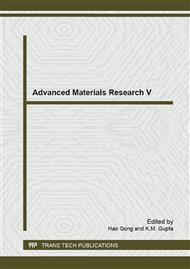p.195
p.203
p.208
p.215
p.220
p.225
p.231
p.237
p.245
The Synthesis and Structure of Anodized Titania Nanotubes for Energy Conversion Materials
Abstract:
Titania nanotubes (TiO2 NTs) photoanodes were synthesized by anodization method. The electrolytes were the mixtures of ethylene glycol (EG), ammonium fluoride (0.3 wt % NH4F) and deionized water (2 Vol % H2O) with different concentrations of dopant Fe (NO3)3∙9H2O. A constant dc power supply at 50 V was used as anodic voltage. The samples were annealed at 450 °C for 2 hours. The resultant products were characterized by Scanning Electron Microscopy (SEM) and X-ray diffraction (XRD) to determine their microstructure when TiO2 NTs were doped with different amounts of Fe atoms. The diameters of TiO2 NTs were about60-120 nm. The highest density of TiO2 NTs was obtained when the nanotubes were doped with 0.01 M of Fe.
Info:
Periodical:
Pages:
220-224
Citation:
Online since:
May 2015
Authors:
Keywords:
Price:
Сopyright:
© 2015 Trans Tech Publications Ltd. All Rights Reserved
Share:
Citation:


